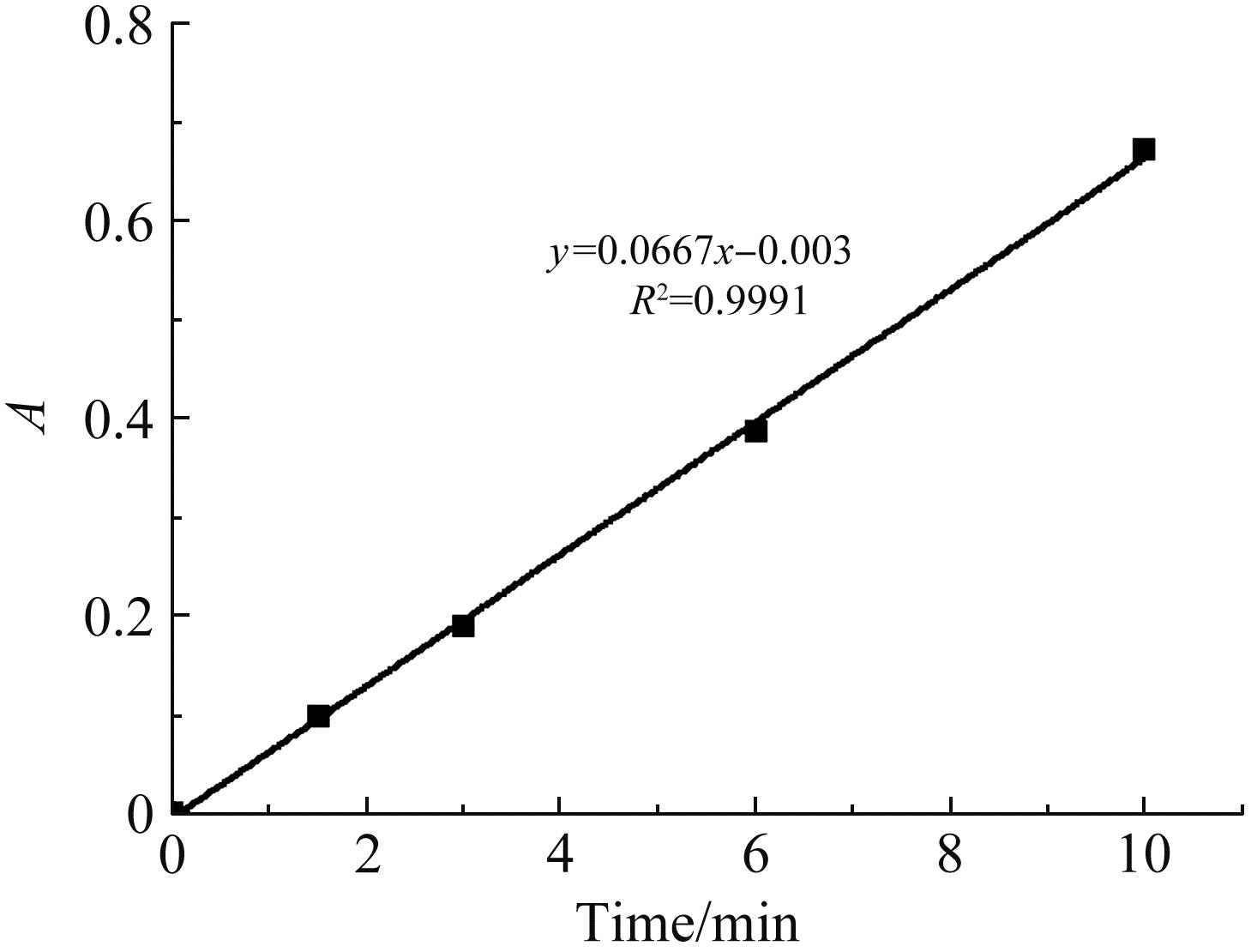
Chinese Journal of Applied Chemistry ›› 2022, Vol. 39 ›› Issue (3): 451-460.DOI: 10.19894/j.issn.1000-0518.210159
• Full Papers • Previous Articles Next Articles
Reductive Degradation of N⁃Nitrosodimethylamine in Water by Ultraviolet Advanced Reduction Processes
Xiao-Song ZHA1,2( ), Lin ZHANG1,2, Yuan-Jie WENG1,2, Zhi-Liang FENG1,2, Su-Wen JIN1,2
), Lin ZHANG1,2, Yuan-Jie WENG1,2, Zhi-Liang FENG1,2, Su-Wen JIN1,2
- 1.School of Environmental Science and Engineering,Tan KahKee College,Xiamen University,Zhangzhou 363105,China
2.Key Laboratory of Estuarine Ecological Security and Environmental Health of Fujian Province,Zhangzhou 363105,China
-
Received:2021-03-31Accepted:2021-08-18Published:2022-03-01Online:2022-03-15 -
Contact:Xiao-Song ZHA -
About author:xszha@xujc.com
-
Supported by:the Natural Science Foundation of Fujian Province of China(2020J05017);the Natural Science Foundation of Zhangzhou City(ZZ2019J11)
CLC Number:
Cite this article
Xiao-Song ZHA, Lin ZHANG, Yuan-Jie WENG, Zhi-Liang FENG, Su-Wen JIN. Reductive Degradation of N⁃Nitrosodimethylamine in Water by Ultraviolet Advanced Reduction Processes[J]. Chinese Journal of Applied Chemistry, 2022, 39(3): 451-460.
share this article
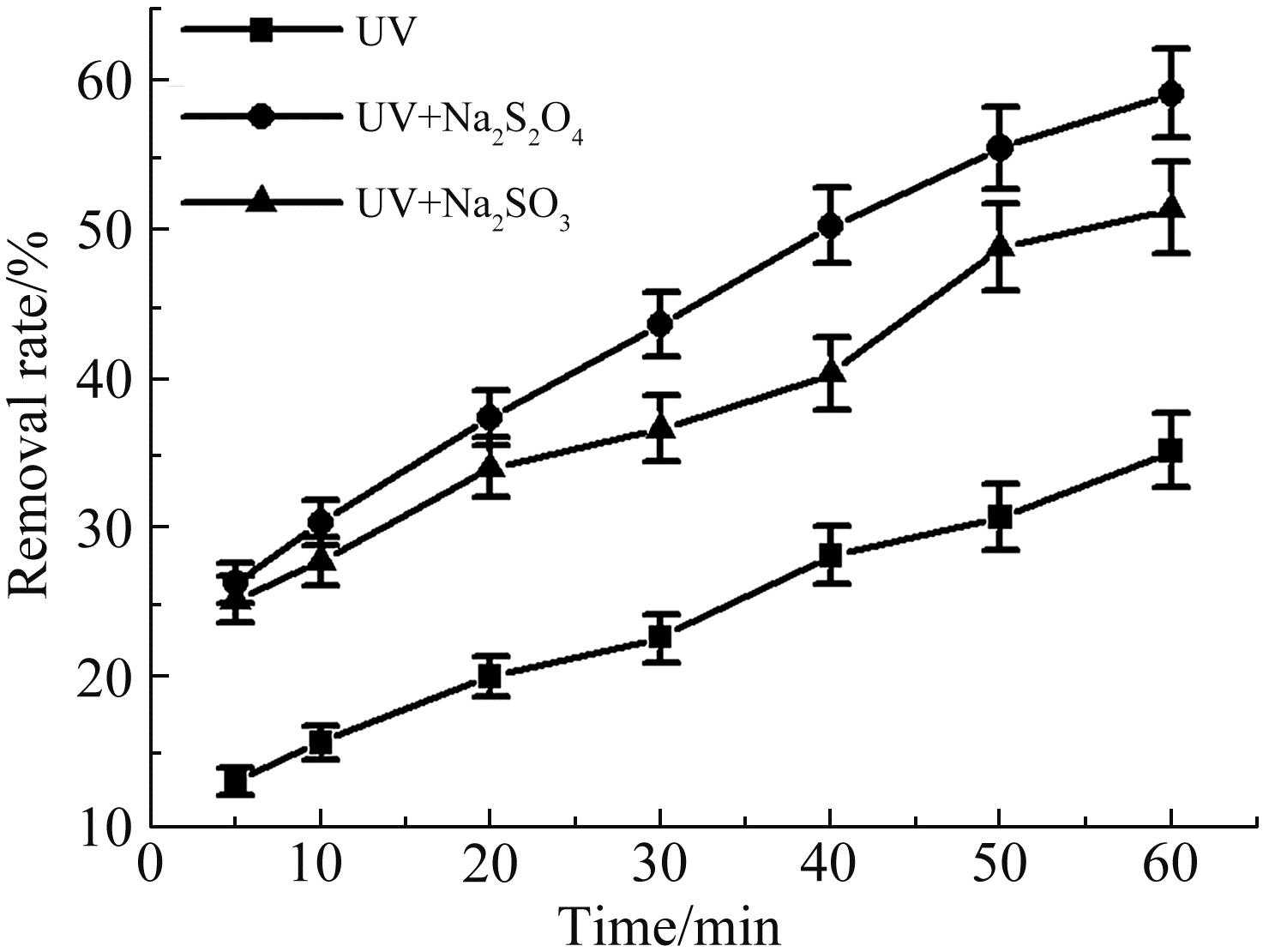
Fig.2 Comparison of the removal efficiency of NDMA in water by UV degradation and two ARPs (Initial reaction conditions: pH=6.2, ρ(DO)=7.85 mg/L, I0=7.56×10-11 E/s)
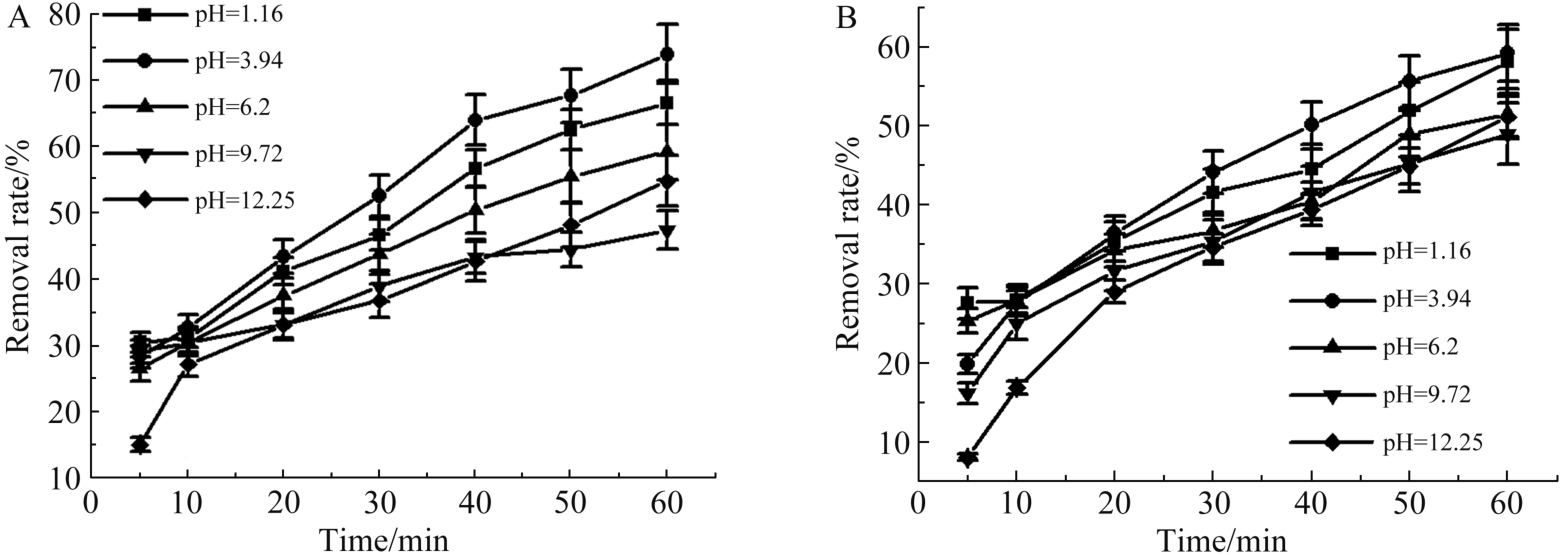
Fig.3 Effect of pH on removal of NDMA by ARPs: A.Na2S2O4 as reductant, B.Na2SO3 as reductant.(Initial reaction conditions: ρ(DO)=7.64 mg/L, I0=7.56×10-11 E/s, the dosage of reductant was 10 mg/L)
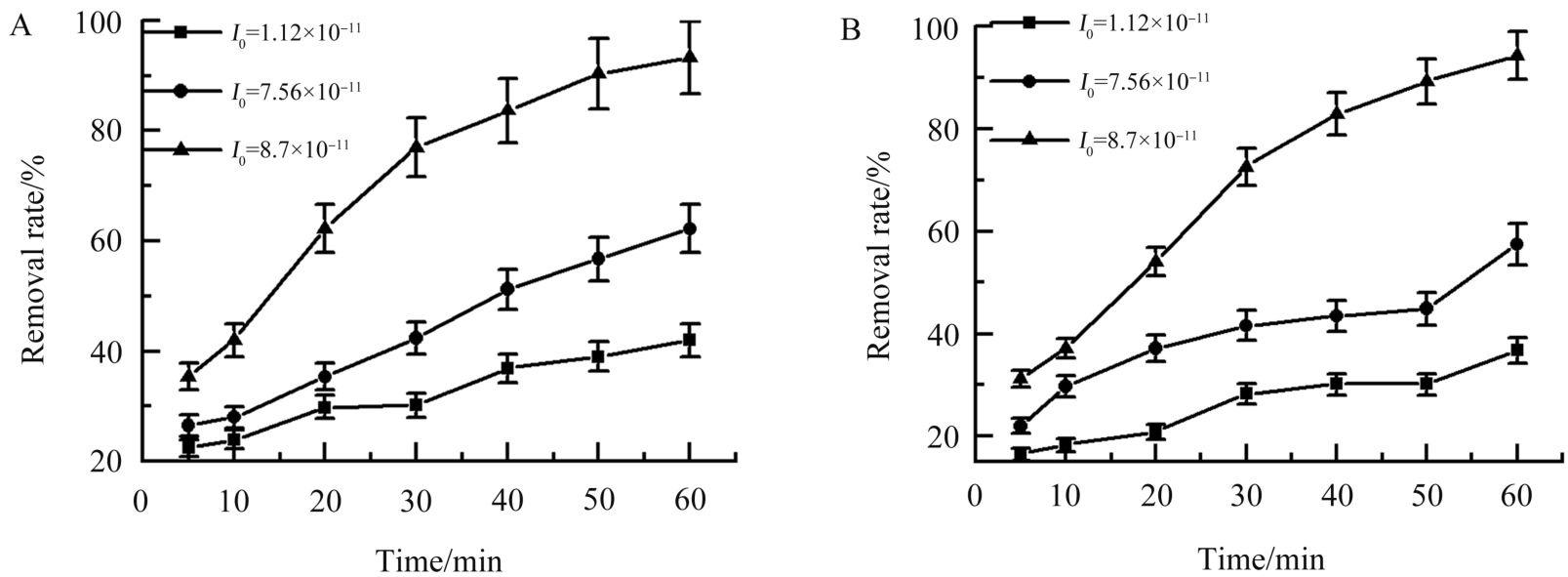
Fig.4 Effect of light intensity on removal of NDMA by ARPs: A.Na2S2O4 as reductant, B.Na2SO3 as reductant.(Initial reaction conditions: pH=6.76, ρ(DO)=7.94 mg/L, the dosage of reductant is 10 mg/L)

Fig.5 Effect of DO on removal of NDMA by ARPs: A. No reductant, B. Na2S2O4 as reductant, C. Na2SO3 as reductant. (Initial reaction conditions: pH=7.2, I0=7.56×10-11 E/s, the dosage of reductant is 10 mg/L)
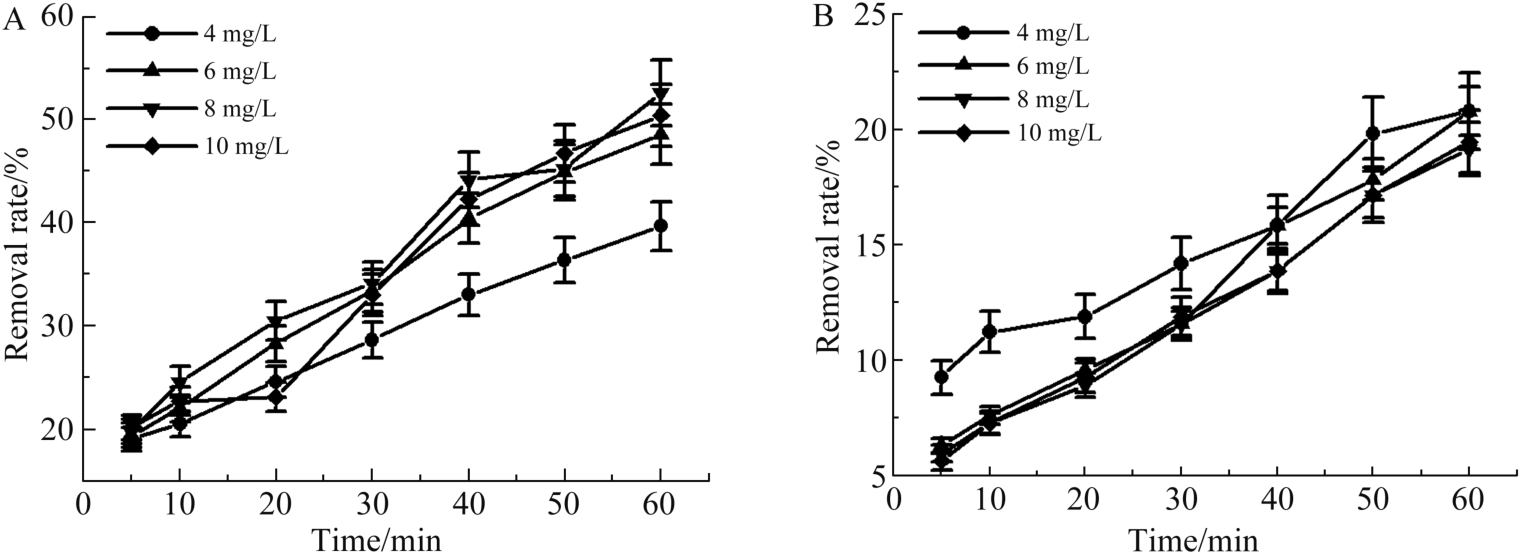
Fig.6 Effect of the dosage of reductant on removal of NDMA by ARPs: A.Na2S2O4 as reductant, B.Na2SO3 as reductant.(Initial reaction conditions: pH=6.76, I0=7.56×10-11 E/s, ρ(DO)=7.81 mg/L)
pH值 pH value | 动力学方程 Kinetic equation | 表观速率常数 Observed rate constant/min-1 | R2 |
|---|---|---|---|
| 1.16 | ln (ρ0/ρ)=0.0142t+0.2538 ln (ρ0/ρ)=0.0099t+0.2403 | 0.014 2 0.009 9 | 0.989 9 0.980 9 |
| 3.94 | ln (ρ0/ρ)=0.0188t+0.2146 ln (ρ0/ρ)=0.0122t+0.1935 | 0.018 8 0.012 2 | 0.993 5 0.992 3 |
| 6.2 | ln (ρ0/ρ)=0.011t+0.2535 ln (ρ0/ρ)=0.0079t+0.2449 | 0.011 0.007 9 | 0.998 7 0.976 7 |
| 9.72 | ln (ρ0/ρ)=0.0058t+0.3097 ln (ρ0/ρ)=0.0085t+0.1779 | 0.005 8 0.008 5 | 0.979 3 0.977 5 |
| 12.25 | ln (ρ0/ρ)=0.0102t+0.1644 ln (ρ0/ρ)=0.0108t+0.0753 | 0.010 2 0.010 8 | 0.972 3 0.980 4 |
Table 1 Kinetic equation of NDMA degradation by UV/Na2S2O4 and UV/Na2SO3 at different pH
pH值 pH value | 动力学方程 Kinetic equation | 表观速率常数 Observed rate constant/min-1 | R2 |
|---|---|---|---|
| 1.16 | ln (ρ0/ρ)=0.0142t+0.2538 ln (ρ0/ρ)=0.0099t+0.2403 | 0.014 2 0.009 9 | 0.989 9 0.980 9 |
| 3.94 | ln (ρ0/ρ)=0.0188t+0.2146 ln (ρ0/ρ)=0.0122t+0.1935 | 0.018 8 0.012 2 | 0.993 5 0.992 3 |
| 6.2 | ln (ρ0/ρ)=0.011t+0.2535 ln (ρ0/ρ)=0.0079t+0.2449 | 0.011 0.007 9 | 0.998 7 0.976 7 |
| 9.72 | ln (ρ0/ρ)=0.0058t+0.3097 ln (ρ0/ρ)=0.0085t+0.1779 | 0.005 8 0.008 5 | 0.979 3 0.977 5 |
| 12.25 | ln (ρ0/ρ)=0.0102t+0.1644 ln (ρ0/ρ)=0.0108t+0.0753 | 0.010 2 0.010 8 | 0.972 3 0.980 4 |
光照强度 Intensity of illumination/(E·s-1) | 动力学方程 Kinetic equation | 表观速率常数 Observed rate constant/min-1 | R2 |
|---|---|---|---|
| 1.12×10-11 | ln (ρ0/ρ)=0.0054t+0.2259 ln (ρ0/ρ)=0.0048t+0.156 | 0.005 4 0.004 8 | 0.978 5 0.949 5 |
| 7.56×10-11 | ln (ρ0/ρ)=0.0112t+0.2273 ln (ρ0/ρ)=0.009t+0.2406 | 0.011 2 0.009 | 0.958 8 0.911 6 |
| 8.70×10-11 | ln (ρ0/ρ)=0.0425t+0.1639 ln (ρ0/ρ)=0.0457t+0.0052 | 0.042 5 0.045 7 | 0.997 1 0.986 6 |
Table 2 Kinetic equation of NDMA degradation by UV/Na2S2O4 and UV/Na2SO3 at different light intensity
光照强度 Intensity of illumination/(E·s-1) | 动力学方程 Kinetic equation | 表观速率常数 Observed rate constant/min-1 | R2 |
|---|---|---|---|
| 1.12×10-11 | ln (ρ0/ρ)=0.0054t+0.2259 ln (ρ0/ρ)=0.0048t+0.156 | 0.005 4 0.004 8 | 0.978 5 0.949 5 |
| 7.56×10-11 | ln (ρ0/ρ)=0.0112t+0.2273 ln (ρ0/ρ)=0.009t+0.2406 | 0.011 2 0.009 | 0.958 8 0.911 6 |
| 8.70×10-11 | ln (ρ0/ρ)=0.0425t+0.1639 ln (ρ0/ρ)=0.0457t+0.0052 | 0.042 5 0.045 7 | 0.997 1 0.986 6 |
DO含量 ρ(DO)/(mg·L-1) | 动力学方程 Kinetic equation | 表观速率常数 Observed rate constant/min-1 | R2 |
|---|---|---|---|
| 8.05 | ln (ρ0/ρ)=0.0044t+0.2613 ln (ρ0/ρ)=0.0026t+0.1299 | 0.004 4 0.002 6 | 0.968 8 0.997 4 |
| 0.85 | ln (ρ0/ρ)=0.007t+0.2483 ln (ρ0/ρ)=0.0049t+0.1277 | 0.007 0.004 9 | 0.976 1 0.991 7 |
Table 3 Kinetic equation of NDMA degradation by UV/Na2S2O4 and UV/Na2SO3 at different DO
DO含量 ρ(DO)/(mg·L-1) | 动力学方程 Kinetic equation | 表观速率常数 Observed rate constant/min-1 | R2 |
|---|---|---|---|
| 8.05 | ln (ρ0/ρ)=0.0044t+0.2613 ln (ρ0/ρ)=0.0026t+0.1299 | 0.004 4 0.002 6 | 0.968 8 0.997 4 |
| 0.85 | ln (ρ0/ρ)=0.007t+0.2483 ln (ρ0/ρ)=0.0049t+0.1277 | 0.007 0.004 9 | 0.976 1 0.991 7 |
| 1 | KRASNER S W, MITCH W A, MCCURRY D L, et al. Formation, precursors, control, and occurrence of nitrosamines in drinking water: a review[J]. Water Res, 2013, 47(13): 4433-4450. |
| 2 | LUO Q, WANG D H, WANG Z J. Occurrences of nitrosamines in chlorinated and chloraminated drinking water in three representative cities, China[J]. Sci Total Environ, 2012, 437: 219-225. |
| 3 | MITCH W A, SHARP J O, TRUSSELL R R, et al. N-Nitrosodimethylamine (NDMA) as a drinking water contaminant: a review[J]. Environ Eng Sci, 2003, 20(5): 389-404. |
| 4 | 梁闯, 徐斌, 夏圣骥, 等. SPE/LC/MS/MS检测水中痕量二甲基亚硝胺[J]. 中国给水排水, 2009, 25(14): 82-85, 92. |
| LIANG C, XU B, XIA S Y, et al. Determination of trace dimethylnitrosamine in water by SPE/LC/MS/MS[J]. China Water Amp, 2009, 25(14): 82-85, 92. | |
| 5 | MA F J, WAN Y, YUAN G X, et al. Occurrence and source of nitrosamines and secondary amines in groundwater and its adjacent Jialu River basin, China[J]. Environ Sci Technol, 2012, 46(6): 3236-3243. |
| 6 | BEI E, SHU Y, LI S, et al. Occurrence of nitrosamines and their precursors in drinking water systems around mainland China[J]. Water Res, 2016, 98: 168. |
| 7 | STEINLE-DARLING E, ZEDDA M, PLUMLEE M H. Evaluating the impacts of membrane type, coating, fouling, chemical properties and water chemistry on reverse osmosis rejection of seven nitrosoalkylamines including NDMA[J]. Water Res, 2007, 41(17): 3959-3967. |
| 8 | FLEMING E C, PENNINGTON J C, WACHOB B G, et al. Removal of N⁃nitrosodimethylamine from waters using physical-chemical techniques[J]. J Hazard Mater, 1996, 51(1/3): 151-164. |
| 9 | JONATHAN O S, THOMAS K W, LISA A C. Aerobic biodegradation of N-nitrosodimethylamine (NDMA) by axenic bacterial strains[J]. Biotechnol Bioeng, 2005, 89(5): 608-618. |
| 10 | STEFAN M I, BOLTON J R. UV direct photolysis of N⁃nitrosodimethylamine (NDMA): kinetic and product study[J]. Helv Chim Acta, 2002, 85(5): 1416-1426. |
| 11 | PAUL S, ALAN R, TIM S, et al. Effectiveness of UV advanced oxidation for destruction of micro-pollutants[J]. Ozone: Sci Eng, 2008, 30(1): 34-42. |
| 12 | 韩莹, 王济禾, 李军, 等. 氧化铜催化零价铁还原水中亚硝基二甲胺[J]. 中国环境科学, 2017, 37(6): 2100-2105. |
| HAN Y, WANG J H, LI J, et al. N-Nitrosodimethylamine reduction in water by zero-valent iron catalyzed by copper oxide[J]. China Environ Sci, 2017, 37(6): 2100-2105. | |
| 13 | 孔露露, 郭晓燕, 周启星, 等. 地表水和饮用水中NDMA的降解方法[J]. 化学进展, 2010, 22(4): 734-739. |
| KONG L L, GUO X Y, ZHOU Q X, et al. Degradation methods of NDMA in surface water and drinking water[J]. Prog Chem, 2010, 22(4): 734-739. | |
| 14 | LEE C H, SCHMIDT C, YOON J, et al. Oxidation of N‑nitrosodimethylamine (NDMA) precursors with ozone and chlorine dioxide: kinetics and effect on NDMA formation potential[J]. Environ Sci Technol, 2007, 41(6): 2056-2063. |
| 15 | HARA K, SAYAMA K, ARAKAWA H. UV photoinduced reduction of water to hydrogen in Na2S, Na2SO3, and Na2S2O4 aqueous solutions[J]. J Photochem Photobiol A, 1999, 128(1/2/3): 27-31. |
| 16 | SONG Z, TANG H, WANG N, et al. Reductive defluorination of perfluorooctanoic acid by hydrated electrons in a sulfite-mediated UV photochemical system[J]. J Hazard Mater, 2013, 262(22): 332-338. |
| 17 | LIU X, YOON S, BATCHELOR B, et al. Degradation of vinyl chloride (VC) by the sulfite/UV advanced reduction process (ARP): effects of process variables and a kinetic model[J]. Sci Total Environ, 2013, 454/455(5): 578-583. |
| 18 | VELLANKI B P, BATCHELOR B. Perchlorate reduction by the sulfite/ultraviolet light advanced reduction process[J]. J Hazard Mater, 2013, 262: 348-356. |
| 19 | BOTLAGUDURU V S V, BATCHELOR B, ABDEL-WAHAB A. Application of UV-sulfite advanced reduction process to bromate removal[J]. J Water Process Eng, 2015, 5: 76-82. |
| 20 | 朱君妍. 苏州太湖饮用水中亚硝胺及其前体物检测方法研究与实践[D]. 苏州科技大学, 2019. |
| ZHU J Y. Study and practice on detection method of nitrosamines and its precursors in drinking water of Taihu lake in Suzhou[D]. Suzhou University of Science and Technology, 2019. | |
| 21 | 钱静汝, 顾斌, 安东. 采用SPE-HPLC-MS/MS(APCI源)检测水中纳克级二甲基亚硝胺[J]. 给水排水, 2017, 53(3): 24-28. |
| QIAN J R, GU B, AN D. Determination of nanogram dimethylnitrosamine in water by SPE-HPLC-MS/MS (APCI source)[J]. Water Supply Drain, 2017, 53(3): 24-28. | |
| 22 | 陈忠林, 韩莹, 杨磊, 等. 零价锌还原水中痕量亚硝基二甲胺的效能[J]. 哈尔滨工业大学学报, 2010, 42(12): 1879-1882. |
| CHEN Z L, HAN Y, YANG L, et al. Reduction efficiency of trace nitrosodimethylamine in water by zero-valent zinc[J]. J Harbin Inst Technol, 2010, 42(12): 1879-1882. | |
| 23 | AMAYREH M S. Determination of N‑nitrosamines in water by automated headspace solid-phase microextraction[J]. Arabian J Sci Eng, 2019, 44(1): 269-278. |
| 24 | 陈忠林, 徐冰冰, 齐虹, 等. 高效液相色谱测定水中痕量亚硝基二甲胺[J]. 中国给水排水, 2007, 196(8): 84-87. |
| CHEN Z L, XU B B, QI H, et al. Determination of trace nitrosodimethylamine in water by high performance liquid chromatography[J]. China Water Amp, 2007, 196(8): 84-87. | |
| 25 | GU Y R, LIU T Z, ZHANG Q, et al. Efficient decomposition of perfluorooctanic acid by a high photo flux UV/sulfite process: kinetics and associated toxicity[J]. Chem Eng J, 2017, 326: 1125-1133. |
| 26 | RAHN R O, STEFAN M I, BOLTON J R, et al. Quantum yield of the iodide-iodate chemical actinometer: dependence on wavelength and concentration[J]. Photochem Photobiol, 2003, 78(2): 146-152. |
| 27 | LEE C, CHOI W, YOON J. UV photolytic mechanism of N⁃nitrosodimethylamine in water: roles of dissolved oxygen and solution pH[J]. Environ Sci Technol, 2005, 39(24): 9702-9709. |
| 28 | BOTLAGUDURU V S V, BATCHELOR B, ABDEL-WAHAB A. Application of UV-sulfite advanced reduction process to bromate removal[J]. J Water Pro Eng, 2015, 5: 76-82. |
| 29 | INMACULADA V, MARIA J F, JELENA R, et al. N‑nitrosodimethylamine (NDMA) degradation by the ultraviolet/peroxodisulfate process[J]. Environ Sci Technol Letter, 2019, 6: 101-111. |
| 30 | 徐冰冰. UV/UV-O3降解水中亚硝胺的效能与机理研究[D]. 哈尔滨: 哈尔滨工业大学, 2008. |
| XU B B. Study on the degradation efficiency and mechanism of nitrosamine in water by UV/UV-O3[D]. Harbin : Harbin Polytechnic Institute, 2008. | |
| 31 | LEE C, CHOI W, KIM Y G, et al. UV photolytic mechanism of N‑nitrosodimethylamine in water: dual pathways to methylamine versus dimethylamine[J]. Environ Sci Technol, 2005, 39(7): 2101-2106. |
| 32 | LI L, LIN X Y, LI Z H. Hydroxylation reaction mechanism for nitrosodimethylamine by oxygen atom[J]. Chem Res Chinese Univ, 2011, 27(6): 1006-9. |
| 33 | MAKAROVS V. Novel trends in chemistry of sulfur-containing reductants[J]. Uspekhi Khimii, 2001, 70(10):996-1007. |
| 34 | FU J, ZHANG Z, TANG J, et al. Photoreduction of reactive brilliant red X-3B by ultraviolet irradiation/potassium borohydride/sodium bisulfite[J]. J Environ Eng-Asce, 2010, 136(11): 1314-1319. |
| 35 | SEID M G, CHO K, HONG S W. UV/sulfite chemistry to reduce N⁃nitrosodimethylamine formation in chlor(am)inated water[J]. Water Res, 2020, 185: 116243. |
| 36 | LI X C, MA J, LIU G F, et al. Efficient reductive dechlorination of monochloroacetic acid by sulfite/UV process[J]. Environ Sci Technol, 2012, 46(13): 7342-7349. |
| 37 | 刘子奇, 赖曼婷, 仇付国, 等. 紫外/亚硫酸盐高级还原工艺加速降解水中难降解含碘造影剂[J]. 环境科学, 2021, 42(3): 1443-1450. |
| LIU A Q, LAI M T, QIU F G, et al. Accelerated degradation of refractory iodine-containing contrast agentin water by UV/sulfite advanced reduction process[J]. Environ Sci, 2021,42(3):1443-1450. | |
| 38 | NAIM S, GHAUCH A. Ranitidine abatement in chemically activated persulfate systems: assessment of industrial iron waste for sustainable applications[J]. Chem Eng J, 2016, 288: 276-288. |
| 39 | SUN Z, ZHANG C, ZHAO X, et al. Efficient photoreductive decomposition of N⁃nitrosodimethylamine by UV/iodide process[J]. J Hazard Mater, 2017, 329: 185-192. |
| [1] | WANG Wen-Hua, MA Jun, ZANG Wen-Sheng, ZHANG Hong-Zhou, GONG Yu-Rong, QI Feng-Li, SU Ji-Gong, WAN Jian-Feng, FAN Hong-Kai. Determination of N-Nitrosodimethylamine in Spiramycin by Gas Chromatography-Tandem Mass Spectrometry [J]. Chinese Journal of Applied Chemistry, 2021, 38(8): 1007-1013. |
| Viewed | ||||||||||||||||||||||||||||||||||||||||||||||||||
|
Full text 689
|
|
|||||||||||||||||||||||||||||||||||||||||||||||||
|
Abstract 710
|
|
|||||||||||||||||||||||||||||||||||||||||||||||||
